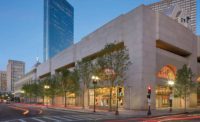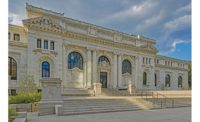John Durcan descends a stairwell in Baltimore’s central Enoch Pratt Free Library to its three subterranean levels—each one as long as a city block—known as “the stacks.” The Gilbane Building Co. senior project manager asks a passing library employee how many books the building can house. “Over a million,” the man says proudly. “It might be more than that.”
That point of pride, however, has kept Durcan up nights. Durcan says he will rest more easily when his team activates the first sprinkler system ever installed in the nearly 85-year-old library. “This is the largest building I’ve ever seen without a sprinkler system,” he says of the 290,000-sq-ft library, which is filled with century-old books and wooden bookshelves. “It’s like a giant kindling box here,” he adds. “We are on pins and needles watching every spark that falls off everything we are welding to make sure it doesn’t land on a book or start a fire.”
“This is the largest building I’ve ever seen without a sprinkler system. It’s like a giant kindling box here.”
– John Durcan, Senior Project Manager, Gilbane Building Co.
To carry out the $115-million renovation of a Baltimore landmark, the project team had to be adaptable, jettisoning documents for an older but never built upgrade and developing new ones to meet the library’s changed role. It also required a series of creative, strategic steps to retain much of the library’s historic features while replacing building systems. In some cases, the techniques saved tens of thousands of dollars.
Keeping part of the library open while work continued in other areas was complicated by the fact that the library serves a half-million visitors annually. The two-phase renovation, which began in June 2016, involves restoring hidden decorative ceiling paintings, interior wood paneling, ornate plasterwork, windows and the historic limestone facade. A new roof was installed, and the team is squeezing updated mechanical, electrical and plumbing systems into narrow spaces. The project is scheduled to finish in March 2019.
Jean Campbell, project manager for lead architect Beyer Blinder Belle Architects & Planners, says watching the library being revitalized is a “joy,” calling the building “truly beautiful” and “majestic.”
The team is aiming to minimize disruption of the building’s historic fabric. For example, instead of demolishing some ceiling cornices and building larger ones to accommodate sprinkler pipes, subcontractors Strickland Fire Protection and EverGreen Architectural Arts snaked sprinkler pipe into one existing cornice to maintain the original sight lines and decorative plaster ceiling patterns in the new “teen room.” Workers removed small cornice sections every few feet to fit pipes inside. They punched out holes for sprinkler heads and patched the cut sections to make the cornice appear to be one continuous piece. “It’s about thinking beyond the architectural documents to find alternative ways,” says Kim Lovejoy, EverGreen senior business developer.
The sprinkler plan saved $40,000, which helped to pay for the full restoration of the original ceiling paintings in the same room. The paintings had been covered with white paint and large, fluorescent 1950s-era “egg-crate” light fixtures. Old black-and-white photos showed original hand-painted scenes in the five ceiling bays, each featuring different native Maryland birds. But the photos didn’t show the paintings’ conditions or colors. The project’s base contract called for repainting the ceiling white. But, as a test, EverGreen used chemical strippers and hand tools to remove patches of paint on one of the paintings, which was revealed to be in fine condition. That test convinced the library to approve a full restoration of that painting. EverGreen partially restored hidden paintings in three or four other rooms.
Similarly, second-floor walls with peeling plaster were slated to be stripped to terra-cotta bedrock. But Gilbane removed enough of the 1960s plasterwork to prove that it was intact, saving $250,000. Wood restoration firm F.C. Vogt helped to save another $1.7 million from the original scope by using other cost-cutting methods on its part of the project. That money was reinvested into additional decorative elements.
John Richardson, the Pratt’s director of facilities for the past 24 years, says library officials’ initial concern that the contractor wouldn’t appreciate the building’s significance proved unfounded. “They’ve made lots of creative suggestions on how to keep some of the things in place,” Richardson says.
Richardson has worked on the project during his entire tenure with the library “in some form or fashion,” he adds. “Every day, you go up there and see the amazing level of detail and workmanship that is taking shape. It’s just amazing.”
Article Index:
Origin Story
Baltimore businessman and philanthropist Enoch Pratt established the city’s library system in 1882 with a $1-million endowment, including a provision for a downtown Central Library, on Mulberry Street.
In 1933, the library moved to a new building on Cathedral Street. The $3-million facility was one of the nation’s first libraries with an open floor plan, with reading rooms directly accessible from the street. “Most libraries at the time were raised above the street level,” Campbell says.
Building improvements were made over the years, but an extensive renovation wasn’t planned until 1998. The renovation’s original design was accompanied by designs for a new, 45,000-sq-ft annex, which was completed in 2003—the same year the Central Library renovation phase of the project was supposed to begin.
But year after year, state funding for the second phase failed to materialize. Richardson says the project sat in a state of “suspension” until 2010, when then-Pratt CEO Carla Hayden revitalized it.
Richardson says Hayden, appointed last year to direct the Library of Congress, tirelessly petitioned state officials to fund the project. It also helped that the library’s fund-raising campaign brought in $5 million more than its $10-million goal. Pratt used the extra money to help rent off-site office space during construction and a 50,000-sq-ft warehouse to house books during the renovation.
Budgeted in the $30-million range, the 1998 renovation plan would have kept the library’s layout mostly intact. But when the project was revived in 2010, Beyer Blinder Belle and managing architect Ayers Saint Gross Architects realized they had to overhaul their original documents. Advances in construction methods and technologies and changes to building codes made the original plan obsolete, Campbell says.
The original documents weren’t adequate because libraries don’t operate as they did 20 years ago, Campbell observes. She says libraries have fewer requirements to conserve and repair books and, with the advent of the internet age, cater more to the general community than to researchers.
Mechanical Movements
The Pratt’s new design includes more classrooms, meeting spaces and multipurpose areas. A new teen and young-adult wing, complete with a recording studio, will occupy half the second floor. Adult services, including more public computers, will be relocated to the first floor.
Before construction started, Richardson had been holding together the building’s MEP infrastructure “with bubble gum and baling wire because we had deferred so many [MEP upgrades] each year, saying, ‘Well, the project will start next year.’ ”
The sub-basement was filled with obsolete and dilapidated mechanical systems that were covered with asbestos and too large to remove easily.
Getting new MEP equipment into the sub-basement required especially creative shoe-horning. For example, when the annex was constructed, an areaway was created to move the old equipment out of the sub-basement and the new equipment in.
Adjacent to the library’s outside air-intake area, the areaway’s approximately 30-ft-deep shaft was capped with precast panels when the annex was built. At the bottom of the shaft, a louver was installed in the 39-in.-thick sub-basement wall. Workers removed the louver and widened the hole in the wall by a few feet on each side to accommodate the largest new unit, a 10.7-ft by 9-ft dehumidification wheel. But because of the way the wheel was manufactured, workers could not tilt the wheel to get it through the hole, Durcan says, adding, “So, we had to come straight through.”
The team installed a materials lift in the areaway to lower equipment down to the opening in the sub-basement wall. Positioned just inside the building, another lift was used to lower equipment to the sub-basement floor. At one point, the hoists were removed so that a 190-ton crane could lower the largest sections of air-handling and energy-recovery units into the areaway. The units were received by a forklift inside the sub-basement.
A 300-ton crane was erected on Cathedral Street one Saturday in April to deliver three fourth-floor and rooftop air-handling units. The crane operator performed blind picks over the building’s central skylight and lowered the units through an aproximately 8-ft by 12-ft louver opening.
The crane also installed vertical mechanical risers for steam, hot water, chilled water and pumps, all of which run through a shaft in the middle of the building, from the sub-basement to the penthouse. The risers were prefabricated in 180-ft lengths and varied in width from 2 in. to 8 in. “We dropped them down [with the crane] once, welded them in place and walked away,” Durcan says of the risers. “The engineering took weeks. The installation took one day.”
Building platforms for crews to erect the risers would have taken two months, Durcan notes.
A different mobile truck crane brought materials into the site’s tight confines. The crane was backed into a 16-ft-wide alley, one of the only access points to the building. The alley leads to a 400-sq-ft laydown area, the only such space on the site’s 45,000-sq-ft footprint. The team doubled the laydown space by building scaffolding about 12 feet off the ground above it.
But in late spring of this year, the scaffolding had to be dismantled to make room for the sprinkler pump’s 13-kV transformer. The transformer’s original location was too close to the building, according to Baltimore Gas and Electric Co. regulations that changed since the project originally was designed. With little laydown area, the team built platforms to store materials, moved materials three or four times and relied on just-in-time deliveries, Durcan says.
The new HVAC system uses district chilled-water and steam systems, rather than a centralized heated hot-water system. The penthouse mechanical room feeds down to the second floor; the sub-basement mechanical room feeds up to the first floor. The system includes six permanent air-handling units, including a 75,000-cfm unit in the sub-basement and a 46,000-cfm unit on the roof.
The district system is less expensive to construct and maintain than a central system, says Darren Anderson, project engineer for MEP engineer Mueller Associates. “Nearly all of our air-handling units are paired with separate heat-recovery ventilator units, so they don’t have heat wheels integral to the air-handling units.”
Anderson says a central plant with chillers, boilers and pumps would have been difficult to construct in the hard-to-reach sub-basement mechanical room. “There’s not big, roll-up doors you can bring big air-handling units in or that kind of stuff,” he says.
Phased Out
The project’s plan originally called for a 36-month schedule that would have renovated the building in three phases, from north to south. During pre-construction, Gilbane determined that a two-phase, top-to-bottom renovation would make better use of the existing HVAC infrastructure. Under the new plan, basement air-handling units would service the library’s open-for-business lower half for two years, while the top half was renovated. Next, library functions would shift to the upper half of the building for one year, while the bottom half was renovated.
During preconstruction, however, the team realized that building out the sub-basement HVAC system required more than one year. That reality meant an earlier-than-planned dismantling of the existing units that service the building’s occupied areas. Two temporary air-handling units, totaling about 100,000 cfm, were installed to keep open the occupied areas, allowing the team to demolish the existing HVAC units and re-install new ones.
But incorporating temporary units into the plan complicated the team’s clash-detection efforts. Laser-scanning technologies don’t distinguish between temporary and permanent infrastructure, Durcan notes. “The scan will tell you there’s a pipe there, but it doesn’t tell you if that pipe needs to be removed, relocated or needs to remain in place until some future point of construction,” he says. The team combed through the digital models to determine when and where temporary pipes should be taken off line so that permanent ones could be brought on line.
Durcan’s team was thrown for a loop a few months into the project, when the library realized it didn’t have enough off-site space to store all of its books. At that point, the Pratt had moved only one stack, or one-third of its collection, off site. Instead of finding more off-site space, the team decided to shuffle books from stack to stack. After the first-stack renovation was completed, workers moved the books in the second stack to the emptied first stack. After the second stack is renovated, books will be moved from the third to the second stack, so the third can be renovated. “We took over the renovation of the first stack and kind of burned the candle from both ends, if you will,” Durcan says.
The team says reconfiguring the phasing, installing temporary air-handling units and reshuffling books are expected to help shave six months off the schedule. Despite all its challenges, the project is on budget—something that would have pleased Enoch Pratt, who was reputed to be a frugal person. It’s also on track to exceed its minority- and veteran-owned business participation goal of 37%, Durcan says—an achievement that also would have aligned with Pratt’s ethos. When he endowed the library, Pratt said, “My library shall be for all—rich and poor without distinction of race or color.”










